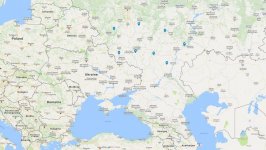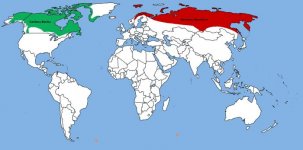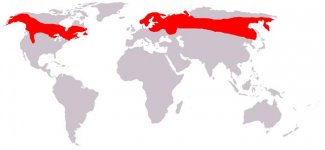A. Papadimitriou
Regular Member
- Messages
- 617
- Reaction score
- 188
- Points
- 43
In Herodotus Histories 4.21 we read:
So the land of the people he called Sauromatae begun 'at the inner end' of the Sea of Azov and stretched 'fifteen days' journey north'.
In the Wikipedia article concerning the "day's journey" we read:
"A Day's journey in pre-modern literature, including the Bible, ancient geographers and ethnographers such as Herodotus, is a measurement of distance.In the Bible, it is not as precisely defined as other Biblical measurements of distance; the distance has been estimated from 32 to 40 kilometers (20–25 miles). In translation by J.B. Bury (Priscus, fr. 8 in Fragmenta Historicorum Graecorum) We set out with the barbarians, and arrived at Sardica, which is thirteen days for a fast traveller from Constantinople. From Constantinople-Istanbul to Sofia is 550–720 km distance at a pace between 42 and 55 km /day."
So, the distance between the inner end of the Sea of Azov to the land of Budini should have been 32x15~55x15km, 480~825km
Concerning the Gelonians he writes:
[The easy solution is to consider the account fictional]. Some scholars, though, have tried to identify the location of the city Herodotus talks about. The Ukrainian archaeologist Boris Shramko thinks that it was located in Bilsk near Poltava in Ukraine, but that is not consistent with the account. Ivan Zabelin, a Russian archaeologist has supported that it was located in Saratov.
I have the impression that Herodotus's North corresponds to a NE direction (I would write about that in another post) but I don't want to force an interpretation.
I marked 8 points in the map, 4 in a distance of ~480km (32x15) from the end of the Sea of Azov and another 4 around ~780km (52x15). Those points theoretically would mark the place where the land of Sauromatae would end and the land of Budini would begin, so Gelonus definitely would have been in a more northern position than that of the line the 4 more southern points form at least, in a heavily forested area, so inside the forest steppe, but possibly in a more northern position than the 4 more northern points too.

If we take into account the following things:
- Fatyanovo culture should have been Baltic speaking and it derived at least partly from the Globula Amphora Culture and possibly the Corded Ware Culture
- Abashevo culture can be the place where some 'Indo-Iranian' loans entered proto-Uralic
Proto-Uralic could have developed in Balanovo and mixed Balanovo-Volosovo sites next to the Baltic Fatyanovo speakers and near the speakers of a Greco-Aryan (?) dialect/language* inside or close to Abashevo.
I write 'Greco-Aryan' because that dialect/language seems to have been non-satem (see for example proto-Indo-Iranian, čakrám, Finnic *kekrä (“yearly feast”) which has semantic parallels also in Greek)
Across the Tanaïs it is no longer Scythia; the first of the districts belongs to the Sauromatae, whose country begins at the inner end of the Maeotian lake and stretches fifteen days' journey north, and is quite bare of both wild and cultivated trees. Above these in the second district, the Budini inhabit a country thickly overgrown with trees of all kinds
So the land of the people he called Sauromatae begun 'at the inner end' of the Sea of Azov and stretched 'fifteen days' journey north'.
In the Wikipedia article concerning the "day's journey" we read:
"A Day's journey in pre-modern literature, including the Bible, ancient geographers and ethnographers such as Herodotus, is a measurement of distance.In the Bible, it is not as precisely defined as other Biblical measurements of distance; the distance has been estimated from 32 to 40 kilometers (20–25 miles). In translation by J.B. Bury (Priscus, fr. 8 in Fragmenta Historicorum Graecorum) We set out with the barbarians, and arrived at Sardica, which is thirteen days for a fast traveller from Constantinople. From Constantinople-Istanbul to Sofia is 550–720 km distance at a pace between 42 and 55 km /day."
So, the distance between the inner end of the Sea of Azov to the land of Budini should have been 32x15~55x15km, 480~825km
Concerning the Gelonians he writes:
The Budini are a great and populous nation; the eyes of them all are very bright, and they are ruddy. They have a city built of wood, called Gelonus. The wall of it is three and three quarters miles in length on each side of the city; this wall is high and all of wood; and their houses are wooden, and their temples; 4.108.2 for there are temples of Greek gods among them, furnished in Greek style with images and altars and shrines of wood; and they honor Dionysus every two years with festivals and revelry. For the Geloni are by their origin Greeks, who left their trading ports to settle among the Budini; and they speak a language half Greek and half Scythian. But the Budini do not speak the same language as the Geloni, nor is their manner of life the same.
4.109.1 The Budini are indigenous; they are nomads, and the only people in these parts that eat fir-cones; the Geloni are farmers, eating grain and cultivating gardens; they are altogether unlike the Budini in form and in coloring. Yet the Greeks call the Budini too Geloni; but this is wrong. 4.109.2 Their whole country is thickly wooded with every kind of tree; in the depth of the forest there is a great, wide lake and a marsh surrounded by reeds; otter is trapped in it, and beaver, besides certain square-faced creatures whose skins are used to trim mantles, and their testicles are used by the people to heal sicknesses of the womb.
[The easy solution is to consider the account fictional]. Some scholars, though, have tried to identify the location of the city Herodotus talks about. The Ukrainian archaeologist Boris Shramko thinks that it was located in Bilsk near Poltava in Ukraine, but that is not consistent with the account. Ivan Zabelin, a Russian archaeologist has supported that it was located in Saratov.
I have the impression that Herodotus's North corresponds to a NE direction (I would write about that in another post) but I don't want to force an interpretation.
I marked 8 points in the map, 4 in a distance of ~480km (32x15) from the end of the Sea of Azov and another 4 around ~780km (52x15). Those points theoretically would mark the place where the land of Sauromatae would end and the land of Budini would begin, so Gelonus definitely would have been in a more northern position than that of the line the 4 more southern points form at least, in a heavily forested area, so inside the forest steppe, but possibly in a more northern position than the 4 more northern points too.

If we take into account the following things:
- Fatyanovo culture should have been Baltic speaking and it derived at least partly from the Globula Amphora Culture and possibly the Corded Ware Culture
- Abashevo culture can be the place where some 'Indo-Iranian' loans entered proto-Uralic
Proto-Uralic could have developed in Balanovo and mixed Balanovo-Volosovo sites next to the Baltic Fatyanovo speakers and near the speakers of a Greco-Aryan (?) dialect/language* inside or close to Abashevo.
I write 'Greco-Aryan' because that dialect/language seems to have been non-satem (see for example proto-Indo-Iranian, čakrám, Finnic *kekrä (“yearly feast”) which has semantic parallels also in Greek)
Last edited:



